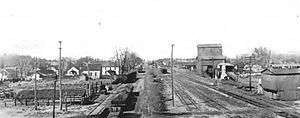Battle of Virden
|
Railroad tracks of Virden, Illinois, c. 1900. | |
| Date | October 12, 1898 |
|---|---|
| Location | Virden, Illinois, United States |
| Coordinates | 39°30′04″N 89°46′00″W / 39.501159°N 89.766646°WCoordinates: 39°30′04″N 89°46′00″W / 39.501159°N 89.766646°W |
| Deaths | 11 |
The Battle of Virden, also known as the Virden Massacre, occurred on October 12, 1898, and was a labor union conflict in Virden, Illinois, involving the United Mine Workers of America. The battle left four security guards and seven striking mine workers dead, with more than thirty people wounded. It was one of several fatal conflicts in the area reflecting both labor union tension and racial violence.
Virden
On September 24, a trainload of potential strikebreaking African-American miners recruited by the Chicago-Virden Coal Company, pulled into Virden on the Chicago & Alton Railroad (C&A RR, multiple tracks to the west, right in the photograph) and were informed by representatives of UMWA Local 693 that they were entering a strike. That train continued north to Springfield, Illinois without incident.
On October 12, 1898, another northbound train pulled into Virden, loaded with about fifty more potential strikebreakers. It had come from Birmingham, Alabama via East St. Louis, where it had taken on detectives from the Thiel Detective Service Company armed with Winchester rifles. It stopped on the C&A RR tracks just outside the minehead stockade. As the strikers attempted to surround the train, the guards opened fire.
The strikers were also armed. As a gun battle broke out in and around the strikebreakers' train, there were dead and wounded on both sides. Seven miners were killed, and 30 wounded; there were four dead Thiel guards, five wounded, and many wounded strikebreakers within the train.[1] Furthermore, had the strikers won the battle, their intentions toward the black Alabama strikebreakers would have been hostile. After twenty minutes of firing on both sides, the train's engineer accepted defeat, and the train engine and tender pulled away from the minehead, leaving the strikebreakers in their cars, and continued northward to Springfield, Illinois.[2]
Calling in the National Guard
Governor Tanner ordered the Illinois National Guard to prevent any more strikebreakers from arriving. He said that if another rail car arrived in the state carrying strikebreakers, that he would "shoot it to pieces with Gatling guns."[3] In compliance to Tanner's orders, the captain in charge of the Illinois Guard at Pana promised:
- "If any negros are brought into Pana while I am in charge, and if they refuse orders to retreat when ordered to do so, I will order my men to fire. If I lose every man under my command no negros shall land at Pana."[4]
The governor admitted that he had no legal authority for his action in preventing the arrival of strikebreakers, but said that he was doing the will of the people.[5]
The mine owners capitulated in mid-November and accepted the UMWA unionization of the Virden coal mines. The union and the mine owners agreed to segregate the Virden mines. Virden itself remained a sundown town for decades thereafter.[2]
A monument in the Virden town square commemorates the coal strike of 1898 and the battle of October 12 that was its bitter end. The monument contains a large bronze bas-relief that includes the names of those killed in the battle, and a copy of a mendacious recruiting handbill distributed by the Chicago-Virden Company in Birmingham, Alabama, to recruit the Negro miners. The body of the bas-relief is made of symbolic representations of the Chicago & Alton tracks and the assault on the strikers. The guards are shown pointing their Winchesters at the strikers and their families. Atop the bas-relief is a bronze portrait of Mary Harris Jones ("Mother Jones").
Mother Jones herself is buried in the Union Miners Cemetery in nearby Mount Olive, Illinois, alongside miners who died in the conflict.[6]
Related conflicts
The same conditions and organizations were also involved in similar conflicts in three other towns: the Pana Massacre in Pana, Illinois on April 10, 1899, in Lauder (now Cambria, Illinois) on June 30, and in Carterville, Illinois on September 17.
Non-unionized Pana, both before and after the events at Virden, had a contingent of state militia called in by Governor John Riley Tanner to keep the peace. The militia withdrew from Pana in March, and on April 10 a skirmish between strikers, guards and strikebreakers left seven killed and at least 15 wounded, many of them bystanders.[1][7]
At Lauder a group of African American miners traveling by train from Pana were attacked on June 30. One woman, Anna Karr, was murdered, and about twenty others wounded. And at Carterville on September 17, five more non-union Negro miners were killed in out-and-out rioting.[1] Local juries acquitted all those accused in those attacks.[8]
See also
References
- 1 2 3 Encyclopedia of American race riots By Walter C. Rucker, James N. Upton, page 673
- 1 2 Rosemary Feuer. "Remember Virden! The Coal Mines Wars of 1898-1900." Illinois History Teacher, Volume 13:2, 2006, pp. 10–22. online edition
- ↑ Paul D. Moreno, Blacks and Organized Labor: a New History, (Baton Rouge: LSU Press, 2008) 61.
- ↑ Paul D. Moreno, Blacks and Organized Labor: a New History, (Baton Rouge: LSU Press, 2008) 61.
- ↑ Paul D. Moreno, Blacks and Organized Labor: a New History, (Baton Rouge: LSU Press, 2008) 61.
- ↑ "Service Tomorrow for Mother Jones," The Washington Post, Dec 2, 1930, pg. 12.
- ↑ Although often repeated, no primary source refers to fatal labor strife in Pana in 1902. http://www.lib.niu.edu/2006/iht1320610.html
- ↑ Bloody Williamson: A Chapter in American Lawlessness By Paul M. Angle

